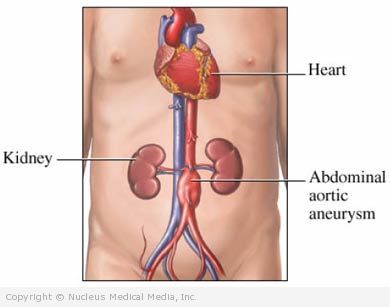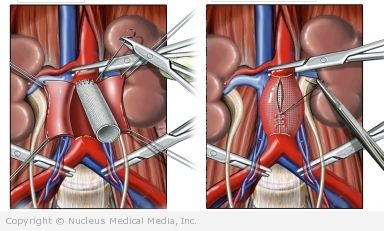Abdominal aortic aneurysm repair
(AAA Repair)
Abdominal aortic aneurysm repair – Definition
The aorta is the largest artery in the body. The abdominal portion of the aorta carries blood to the abdomen, pelvis, and legs. Sometimes the walls of the aorta weaken and bulge in one area. This is called an abdominal aortic aneurysm (AAA). AAA’s are most often caused by atherosclerosis (hardening of arteries) and high blood pressure.
Abdominal aortic aneurysm repair – Reasons for Procedure
Surgery to repair an AAA is often done when the aneurysm:
- Causes physical symptoms (eg, abdominal pain)
- Reaches a size of five centimeters (about two inches) across or has been growing rapidly. Smaller aneurysms are watched closely. They are rarely repaired with surgery.
- Has burst — Surgery must be done immediately.
Preventive AAA surgery generally has a good outcome for people who are relatively healthy. Emergency surgery to fix an AAA rupture has a much lower survival rate, due to the rapid loss of blood.
Abdominal aortic aneurysm repair – Possible Complications
Your doctor will review a list of possible complications, which may include:
- Problems from general anesthesia (eg, light-headedness, low blood pressure, wheezing)
- Infection
- Bleeding
- Damage to organs
- Death
Some factors that may increase the risk of complications include:
- Smoking
- Heart disease
- Previous episodes of transient ischemic attack or stroke
- Lung disease
- Weakness due to cancer
- Diabetes
- Obesity
Abdominal aortic aneurysm repair – What to Expect
The procedure varies. It can be done before a rupture (preventive) or after a rupture (emergency). The preventive procedure is outlined here.
Prior to Procedure
Your doctor may need detailed pictures of your abdomen, heart, and lungs. These can be made with:
- CT scan
- MRI scan
- Chest x-ray
- Abdominal ultrasound
Your doctor may also need a record of your heart activity. This can be made with:
- Electrocardiogram
Your doctor may ask you to see a cardiologist (a doctor who specializes in heart conditions). The cardiologist will check your heart before surgery.
Before the procedure:
- You may need to stop taking certain medicines one week before surgery. Talk to your doctor about your regular medicine, especially:
- Aspirin and other nonsteroidal anti-inflammatory drugs (eg, ibuprofen, naproxen)
- Blood-thinning drugs, such as warfarin (Coumadin)
- Anti-platelet drugs, such as clopidogrel (Plavix)
On the day of the procedure, you will be given an antibiotic by IV. You may also be given a laxative or enema to clear out your bowels.
Abdominal aortic aneurysm repair – Anesthesia
General anesthesia will be used. It will block any pain and keep you asleep through the surgery. It is given through an IV.
Abdominal aortic aneurysm repair – Description of Procedure
In most cases, an incision is made from the breastbone to below the belly button. The doctor clamps the aorta slightly above and below the aneurysm. Any blood clot on the inside of the aorta is removed. An artificial wall is used to strengthen the area. This is called a graft. The graft will be stitched to the normal aorta on either side. Then the clamps are removed. The wound is closed with stitches.
Abdominal aortic aneurysm repair – How Long Will It Take?
About 4-6 hours
Abdominal aortic aneurysm repair – How Much Will It Hurt?
Anesthesia prevents pain during the procedure. Most people will be sore after the procedure and will be given pain medicines.
Abdominal aortic aneurysm repair – Average Hospital Stay
The length of your hospital stay depends on your overall condition. Ask your doctor how long you should plan to stay.
Abdominal aortic aneurysm repair – Post-procedure Care
At the Hospital
While you are recovering at the hospital, you may receive the following care:
- You will be sent to the intensive care unit for monitoring.
- You will have tubes in place, which may include the following:
- Urinary catheter — monitors urine output
- Arterial catheter — monitors blood pressure
- Central venous catheter — monitors pressure in the heart
- Epidural catheter — provides pain medicine
- Nasogastric tube — inserted through the nose and into the stomach to remove secretions and provide nutrition until your intestines regain normal function
At Home
When you return home, do the following to help ensure a smooth recovery:
- Follow any discharge instructions to care for the wound.
- Gradually return to your normal activities.
- To help prevent further problems, you and your doctor will need to work to increase your overall health. Atherosclerosis and high blood pressure should be managed carefully. This can be done with medicines and a healthful lifestyle. If you are a smoker, you should talk to your doctor about quitting.
Also, ask your doctor about when it is safe to shower, bathe, or soak in water.
Abdominal aortic aneurysm repair – Call Your Doctor
After you leave the hospital, contact your doctor if any of the following occurs:
- Redness, swelling, increasing pain, excessive bleeding, or discharge at the incision site
- Signs of infection, including fever and chills
- New abdominal pain
- Back pain
- Any change of color or sensation in your legs or feet
- Burning, pain, or problems when urinating
- Nausea or vomiting
- Abdominal cramps or diarrhea
- Unusual fatigue or depression
- Disorientation or confusion
- Numbness or tingling in the legs
- New, unexplained symptoms
- Cough, shortness of breath, or chest pain
In case of an emergency, call for medical help right away.


